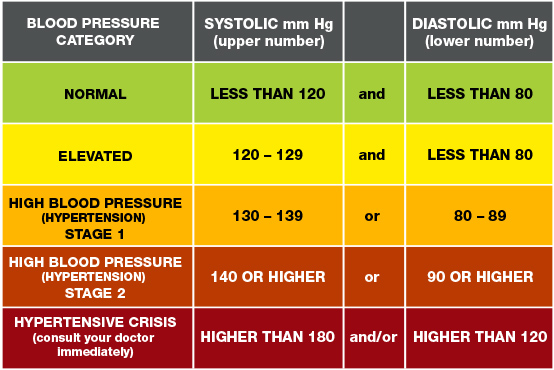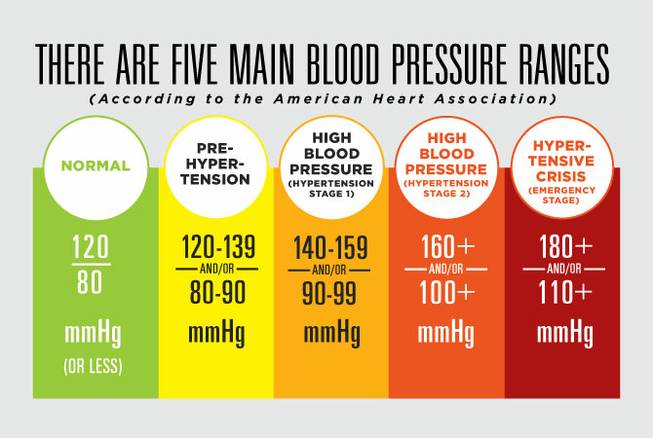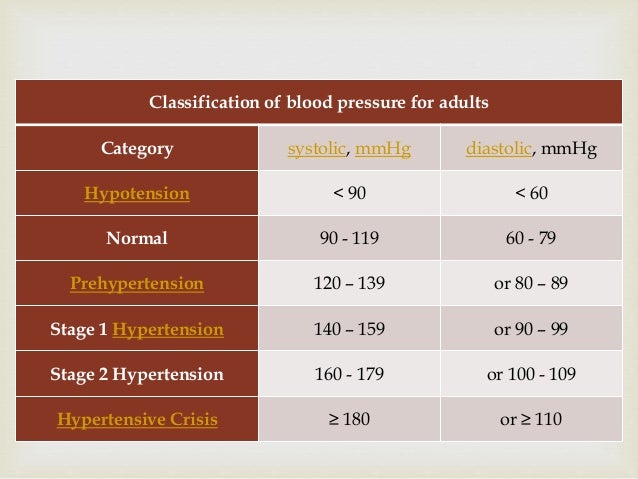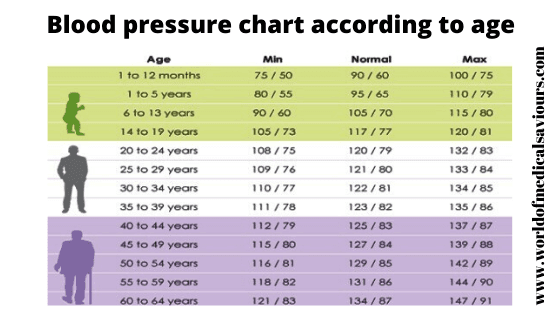Normal blood pressure is between 90/60 and 130/80 The top number, or systolic pressure, is a measurement of the pressure in the arteries when the heart muscle contracts The bottom number, or diastolic pressure, is a measurement of the pressure in the arteries between beats of the heart Hypotension, or low blood pressure, happens when yourIn severe cases, low blood pressure can be lifethreatening A blood pressure reading lower than 90 millimeters of mercury (mm Hg) for the top number (systolic) or 60 mm Hg for the bottom number (diastolic) is generally considered low blood pressure The causes of low blood pressure can range from dehydration to serious medical disordersA blood pressure reading of 90/60 mm Hg (or lower) is considered low blood pressure Low blood pressure may be a sign of an underlying condition, so your doctor will try to determine what caused your blood pressure to drop

Understanding Blood Pressure Readings American Heart Association
90/60 blood pressure male
90/60 blood pressure male-If your blood pressure is 1/80 millimeters of mercury (mm Hg) or lower, it's considered normal Generally, if the blood pressure reading is under 90/60 mm Hg, it is abnormally low and is referredPeople with a reading of around 90/60, or less, are commonly regarded as having low blood pressure If you have low blood pressure, you have (to a certain degree) some protection against factors that increase blood pressure, such as eating too much salt, not eating enough fruit and vegetables, or being overweight



Visual Guide To Low Blood Pressure
Advertisement Normal blood pressure is defined when the top number (systolic) is less than 1 mm Hg and the bottom number is under 80 mm Hg Anything less than 90 over 60 is considered low, but low doesn't always mean unhealthy or dangerous Sometimes there are reasons for low blood pressureAdvertisement Normal blood pressure is defined when the top number (systolic) is less than 1 mm Hg and the bottom number is under 80 mm Hg Anything less than 90 over 60 is considered low, but low doesn't always mean unhealthy or dangerous Sometimes there are reasons for low blood pressureReadings at or below 90/50 usually indicate low blood pressure or what is called HypotensionWhat this means is the blood pressure in your arteries is lower than what is considered normal
If your blood pressure is lower than 90/60, you have low blood pressure, or hypotension You may feel lightheaded, weak, dizzy, or even faint Low blood pressure can be caused by not drinking enough liquids (dehydration), blood loss, some medical conditions, or too much medication Some High Blood Pressure Risks You Can't ChangeFor 90/61 to be good, both numbers must fit into the "normal" category above Otherwise, it will fall into other categories of High Blood Pressure Systolic reading of 90 is in the Normal range Diastolic reading of 61 is in the Normal rangeLow blood pressure, or hypotension, occurs when the blood pressure drops below 90/60 mm Hg Some people have a naturally low blood pressure, but a sudden drop can cause symptoms to develop
Hypotension is the medical term for low blood pressure (less than 90/60) A blood pressure reading appears as two numbers The first and higher of the two is a measure of systolic pressure, or theA blood pressure reading lower than 90 millimeters of mercury (mm Hg) for the top number (systolic) or 60 mm Hg for the bottom number (diastolic) is generally considered low blood pressure The causes of low blood pressure can range from dehydration to serious medical disordersSince blood pressure tends to increase with age, some medical societies argue about the effectiveness and safety of treating older adults for high blood pressure Overall, older adults should aim for lower blood pressure numbers but a blood pressure reading of 90/60 mm Hg or lower is considered too low (hypotension)



Understanding The Highs And Lows Of Your Blood Pressure Reading Mountainview Hospital



Blood Pressure
"A young healthy patient may have a resting blood pressure of 90/60 mmHg and feel absolutely fine," he says "On the other hand, an older patient with heart problems, might feel weak and dizzy with a blood pressure of 115/70 mmHg"There are two parts or two separate numbers referred to as blood pressure Systolic/Diastolic If the blood pressure is 90/61 (90 over 61), it means that the systolic pressure is 90 and the diastolic pressure is 61 90/61 blood pressure can also be read as 90/61 mm Hg, or 90/61 millimeters of mercury The 90 mm Hg Systolic refers to the pressure in the arteries when the heart beats, and the 61 mm Hg Diastolic is the pressure in the arteries between heartbeatsBlood pressure readings fall into four general categories, ranging from normal to stage 2 high blood pressure (hypertension) The level of your blood pressure determines what kind of treatment you may need To get an accurate blood pressure measurement, your doctor should evaluate your readings based on the average of two or more blood pressure



Understanding Low Bp Or Low Blood Pressure How To Prevent



What Is Low Blood Pressure And Is It Harmful Carrington College
Normal blood pressure in adults is less than 1/80 mmHg Low blood pressure is a reading below 90/60 mmHg Most forms of hypotension happen because your body can't bring blood pressure back to normal or can't do it fast enough, says the National Heart, Lung and Blood Institute For some people, low blood pressure is normalWhat does a blood pressure reading of 90/50 mean?But when blood pressure regularly spikes higher than normal, it's a sign that something isn't right Doctors call the condition labile hypertension, and it merits investigation



Normal Blood Pressure For 30 Years Old Prohibitive Blood Vexation



New Blood Pressure Guidelines Raise Controversy
Very Low Nl, Maybe Since the pulse pressure (9050=40 mmhg) is reasonable, possibly accurate & possibly ok if heart output good, can function well & not dizzy on standing Keep in mind 90 read/estimated from only one heart/pulse beat, 50 only one heart/pulse beat & not the same heart/pulse beat values can (& commonly do) change rapidlyNormal blood pressure is between 90/60 and 130/80 The top number, or systolic pressure, is a measurement of the pressure in the arteries when the heart muscle contracts The bottom number, or diastolic pressure, is a measurement of the pressure in the arteries between beats of the heart Hypotension, or low blood pressure, happens when your child's blood pressure falls below the normal range144/90 60 to 64 years 134/87 121/ 174/91 Normal Blood Pressure for Women In keeping with the normal blood pressure levels, most women fall along the same lines as men It should be noted, however, that the female body experiences many physiological changes Pregnancy and the menstruation cycle has a major impact on blood pressure



Pin On World Heart Day Make A Healthy Choice For An Healthy Heart



Blood Pressure Range Chart Blood Pressure Magnesium
If you have just had a blood pressure exam and your blood pressure is 90/60, it is very likely that you have low blood pressure, which is also known as hypotension It is important to remember that many factors affect your blood pressure level, and such a reading can be completely normal for you, if you have no symptoms of low blood pressure"A young healthy patient may have a resting blood pressure of 90/60 mmHg and feel absolutely fine," he says "On the other hand, an older patient with heart problems, might feel weak and dizzy with a blood pressure of 115/70 mmHg"According to the American Heart Association (AHA), a normal blood pressure reading is 1/80 mm Hg and below Readings below 90/60 mm Hg indicate low blood pressure, or hypotension Readings above



Maintaining A Normal Blood Pressure In Seniors Elmcroft Com



What Is Normal Blood Pressure



0 件のコメント:
コメントを投稿